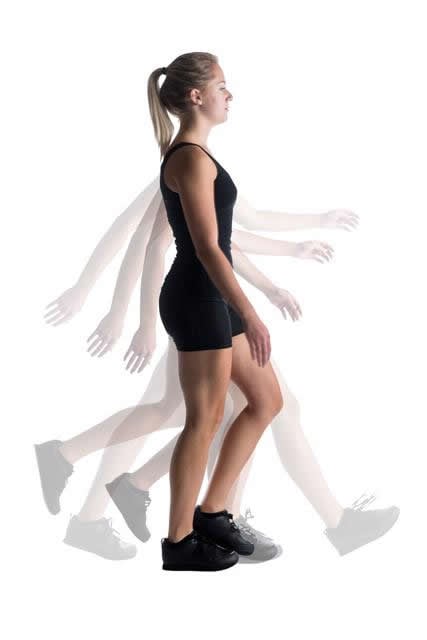Those of you who spend hours at the gym with the aim of burning as many calories as possible may be disappointed to learn that all the while your nervous system is subconsciously working against you. Researchers reporting in the Cell Press journal Current Biology on September 10 have found that our nervous systems are remarkably adept in changing the way we move so as to expend the least amount of energy possible. In other words, humans are wired for laziness.
The findings, which were made by studying the energetic costs of walking, likely apply to most of our movements, the researchers say.
“We found that people readily change the way they walk–including characteristics of their gait that have been established with millions of steps over the course of their lifetime–to save quite small amounts of energy,” says Max Donelan of Simon Fraser University in Canada. “This is completely consistent with the sense that most of us have that we prefer to do things in the least effortful way, like when we choose the shortest walking path, or choose to sit rather than stand. Here we have provided a physiological basis for this laziness by demonstrating that even within a well-rehearsed movement like walking, the nervous system subconsciously monitors energy use and continuously re-optimizes movement patterns in a constant quest to move as cheaply as possible.”

There is a bright side to this, lead author Jessica Selinger adds: “Sensing and optimizing energy use that quickly and accurately is an impressive feat on the part of the nervous system. You have to be smart to be that lazy!”
Donelan, Selinger, and their colleagues wanted to understand why people move the way they do, given that there are countless ways to get from point A to point B. This is partly a question of evolution and learning. But, the researchers wanted to know, to what extent can our bodies adapt movement based on real-time physiological inputs?
To find out, the researchers asked people to walk while they wore a robotic exoskeleton. This contraption allowed the researchers to discourage people from walking in their usual way by making it more costly to walk normally than to walk some other way. More specifically, the researchers made it more difficult for participants to swing their legs by putting resistance on the knee during normal walking, whereas the researchers eased this resistance for other ways of walking.
“We think of our experiment like dropping someone into a new world with all new rules,” Selinger says. “Any walking strategies that may have developed over evolutionary or developmental timescales are now obsolete in this new world.”
This scheme allowed the researchers to test whether people can sense and optimize the cost associated with their movements in real time. And it turns out we can.
The experiment revealed that people adapt their step frequency to converge on a new energetic optimum very quickly–within minutes. What’s more, people do this even when the energy savings is quite small: less than 5%. The findings show that the energetic costs of our activities aren’t just an outcome of our movements, but in fact play a central role in continuously shaping them.
The researchers say they now plan to explore questions about how the human body measures the energetic costs associated with particular ways of moving. They are also keen to know how the body solves what is a very complex optimization problem.
“Walking requires the coordination of literally tens of thousands of muscle motor units,” Donelan says. “How do we so quickly discover the optimal combinations?”
Funding: This work was supported by a Vanier Canadian Graduate Scholarship, the Michael Smith Foundation for Health Research, and the U.S. Army Research Office.
Source: Joseph Caputo – Cell Press
Image Credit: The image is credited to Greg Ehlers
Original Research: Abstract for “Humans Can Continuously Optimize Energetic Cost during Walking” by Jessica C. Selinger, Shawn M. O’Connor, Jeremy D. Wong, and J. Maxwell Donelan in Current Biology. Published online September 10 2015 doi:10.1016/j.cub.2015.08.016
Abstract
Humans Can Continuously Optimize Energetic Cost during Walking
Highlights
•People readily adapt established gait patterns to minimize energy use
•People converge on new energetic optima within minutes, even for small cost savings
•Updated predictions about energetically optimal gaits allow re-convergence within seconds
•Energetic cost is not just an outcome of movement, but also continuously shapes it
Summary
People prefer to move in ways that minimize their energetic cost [ 1–9 ]. For example, people tend to walk at a speed that minimizes energy use per unit distance [ 5–8 ] and, for that speed, they select a step frequency that makes walking less costly [ 3, 4, 6, 10–12 ]. Although aspects of this preference appear to be established over both evolutionary [ 9, 13–15 ] and developmental [ 16 ] timescales, it remains unclear whether people can also optimize energetic cost in real time. Here we show that during walking, people readily adapt established motor programs to minimize energy use. To accomplish this, we used robotic exoskeletons to shift people’s energetically optimal step frequency to frequencies higher and lower than normally preferred. In response, we found that subjects adapted their step frequency to converge on the new energetic optima within minutes and in response to relatively small savings in cost (<5%). When transiently perturbed from their new optimal gait, subjects relied on an updated prediction to rapidly re-converge within seconds. Our collective findings indicate that energetic cost is not just an outcome of movement, but also plays a central role in continuously shaping it.
“Association of Predeployment Heart Rate Variability With Risk of Postdeployment Posttraumatic Stress Disorder in Active-Duty Marines” by Arpi Minassian, PhD; Adam X. Maihofer, MS; Dewleen G. Baker, MD; Caroline M. Nievergelt, PhD; Mark A. Geyer, PhD; and Victoria B. Risbrough, PhD; for the Marine Resiliency Study Team in JAMA Psychiatry. Published online September 9 2015 doi:10.1001/jamapsychiatry.2015.0922






